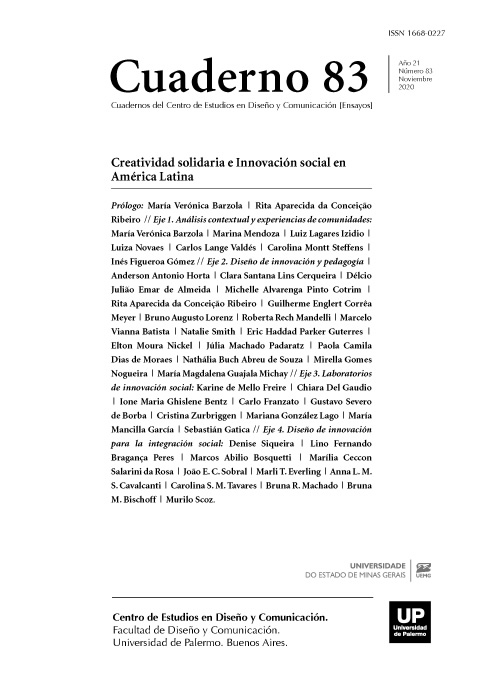O idoso, sua casa e suas coisas:contribuições para criação de um entorno mais acolhedor para os maiores de 60 anos
Abstract
In Brazil, we experience the unprecedented phenomenon of population aging and longevity. In less than a decade the number of the eldery will exceed the Young, with this new reality also arise new behaviors, desires and demands. The purpose of this article is to provide information about the relationship of affection of the elderly with their home and their objects, and to provide subsidies for the construction of an environment more suitable for those who are aging. This article is structured in 5 sections that present: (1) the demographic panorama and the tendencies of the household arrangements of the elderly in Brazil; (2) hypotheses brought from different areas about the relationship of the elderly with their homes, (3) reflections about the home and the artifacts as support of memory and identity; (4) the relation of the elderly with their houses and things according to results obtained in qualitative research. Finally, it is expected to provide an alert to professionals involved in the creation of environments, products and services that take into account the desires, aspirations and feelings of the elderly, especially regarding their preferences about housing. In this way, the article joins other studies that provide subsidies for those who want to develop products, services and environments that meet the emotional demands of this population, providing them with a better quality of life.
References
Alvez, J. e Cavanachi, S. (2012). Tendências demográficas, dos domicílios e das famílias no Brasil, em Aparte Inclusão Social em Debate. Disponível em: http://www.ie.ufrj.br/aparte/pdfs/tendencias_demograficas_e_de_familia_24ago12.pdf Acesso em: 28 dez. 2017.
Beauvoir, S. (1990). Velhice. Rio de Janeiro: Nova Fronteira. Baudrillard, J. (2004). O sistema dos objetos. São Paulo: Perspectiva.
Camarano, A. (2002). Envelhecimento da população brasileira: uma contribuição demográfica. Rio de Janeiro: IPEA (Texto para Discussão, 858).
Camarano, A. e Ghaouri, S. (2003). Famílias com Idosos: Ninhos Vazios? Rio de Janeiro: IPEA.
Camarano, A., et.al. (2004). “Como vive o Idoso Brasileiro?”, em Camarano, A. Os Novos Idosos Brasileiros: muito além dos 60? IPEA: Rio de Janeiro.
Camargos, M. et. al. (2011). “Idoso, família e domicílio: uma revisão narrativa sobre a decisão de morar sozinho”, em R. bras. Est. Pop., Rio de Janeiro, v. 28, n. 1, p. 217-230.
Caradec, V. (2016). “Da terceira Idade à idade avançada: a conquista da velhice”, em Goldenberg, M. (2016). Velho é lindo. Rio de Janeiro: Civilização Brasileira.
Csikszentimihal Yi, M. e Rochbeng-Halton, E. (1981). The Meaning of Things: Domestic Symbols and the Self. New York: Cambridge University Press.
Damazio, V. (2005). Artefatos de Memória da Vida Cotidiana: um olhar interdisciplinar sobre as coisas que fazem bem lembrar. Tese de Doutorado em Ciências Sociais, UERJ, Rio de Janeiro.
Duarte, C. (2013). “Moldagem do lugar; remoldagem do olhar”, em Novos olhares sobre o lugar: ferramentas e metodologias, da arquitetura a antropologia. Rio de Janeiro: Contra Capa.
Ekambi-Schmidt, J. (1974). La Percepción del Hábitat. Barcelona: Gustavo Gili.
Ferreira, M., em Barros, M. (2006). Velhice ou Terceira idade? Estudos antropológicos sobre identidade, memória e política. Rio de Janeiro: FGV, p. 207-222.
Goldenberg, M. (2013). A Bela Velhice. Rio de Janeiro: Record. Goldenberg, M. (2014). Cuidar da casa pode ser seu melhor objetivo. Casa e Jardim Globo.
Goldenberg, M. (2015). Novas casas para novos idoso. Casa e Jardim.
Goldenberg, M. (2016). Velho é lindo. Rio de Janeiro: Civilização Brasileira.
Halbwachs, M. (1990). A Memória Coletiva. São Paulo: Vértice.
Helpage International (2015). Global AgeWatch Index 2015. Disponível em: <http://www.helpage.org/global-agewatch/population-ageing-data/global-rankings-table/> Acesso em: 9 set.
IBGE, Censos demográficos e PNADs, diversos anos. McKracken, G. (2003). Cultura e Consumo. Rio de Janeiro: Mauad.
McKracken, G. (2007). Cultura e Consumo: uma explicação teórica da estrutura e do movimento do significado cultural dos bens de consumo. RAE-Clássicos, São Paulo. V. 47, n.1, pag. 99-115, Jan./mar.
Organização Mundial da Saúde (2005). Envelhecimento ativo: uma política de saúde. Brasília: Organização Pan-Americana da Saúde.
Organização Mundial da Saúde (2007). Guia Global: Cidade Amiga do Idosos. Brasília: Organização Pan-Americana da Saúde.
Tuan, Y. (1983). Espaço e Lugar: A Perspectiva da Experiência. São Paulo: Difel. United Nations (2005). Living arrangements of older persons around the world. New York.
United Nations (2017). World Population Prospect. The 2017 revision. New York.
Wold Helth Organization (2015). World Report on Ageing and Health. Geneva.
Los autores/as que publiquen en esta revista ceden los derechos de autor y de publicación a "Cuadernos del Centro de Estudios de Diseño y Comunicación", Aceptando el registro de su trabajo bajo una licencia de atribución de Creative Commons, que permite a terceros utilizar lo publicado siempre que de el crédito pertinente a los autores y a esta revista.


